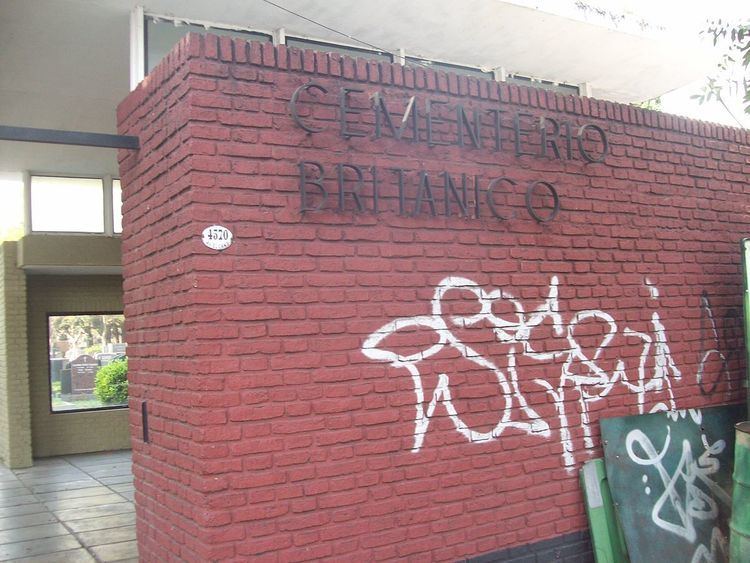Established 1822 Find a Grave Cementerio Británico | Type not extant Phone +54 11 4553-3403 | |
 | ||
Hours Open today · 9AM–5PMTuesday9AM–5PMWednesday9AM–5PMThursday9AM–5PMFriday9AM–5PMSaturday9AM–5PMSunday9AM–5PMMonday9AM–5PM | ||
Cementerio brit nico
Cementerio Británico de Buenos Aires, also known in English as Buenos Aires British cemetery, is a cemetery in Buenos Aires, Argentina. It is in the district of Chacarita in the northern part of Buenos Aires, adjacent to La Chacarita Cemetery.
Contents
- Cementerio brit nico
- Antonio las heras recorre centenarias tumbas mas nicas en el cementerio brit nico
- History of the British Cemetery
- Protestant Cemetery of Victoria
- At La Chacarita
- War graves
- Garden Cemetery in Pablo Nogus
- Management
- Famous interments
- References
Antonio las heras recorre centenarias tumbas mas nicas en el cementerio brit nico
History of the British Cemetery
The British Cemetery was established on February 21, 1822. The first address was Juncal Street, beside the building that houses Socorro Church.
On 1833 the Cemetery was moved to Victoria Street, (today Hipólito Yrigoyen), between Pasco and Pichincha, until 1892. The site is today a plaza called "1 de Mayo".
Protestant Cemetery of Victoria
In May, 1827 the British consul Woodbine Parish started negotiations with the government to obtain permission for the British community to build a new temple and another plot for the cemetery, since the existing cemetery (at Socorro) was full.
In February, 1829, the Rosas government made available a plot for the construction of the temple, but there were no funds for the donation of the land for the new cemetery. On August 21, 1832, the then British consul Griffiths reported that the British government would cover half of the expenses necessary for the new cemetery.
In 1833 Victoria Cemetery was opened in today's Plaza 1° de Mayo, between Hipólito Yrigoyen Street (then Victoria Street) and Pasco, Alsina and Pichincha Streets.
The new land, measuring 100m x 100m, was acquired from Manuel La Serna and Maria Luisa Roseti for $4,500. The land was more expensive than expected, and the estimated budget was insufficient to finish the project. In March, 1833 the Buenos Aires English language newspaper, The British Packet, reported that the subscriptions were not sufficient so more contributions were requested from the community.
When on June 7, 1833 the purchase of the land was concluded it was agreed that it was exclusively for Protestants of the city.
Victoria Cemetery received its first two British burials on November 6, 1833.
The plots were freely transferable, but no trees could be planted; no tablets or monuments against the walls or common space were allowed. Carriages, wagons, horses or cattle were not allowed to enter. The gravedigger would take record and deliver a copy to the British chaplain for the official record.
Victoria Cemetery remained open for almost sixty years, with a temporary closure in two occasions: during Hilario Lagos's siege in 1853, and during the yellow fever outbreak in 1871, when the government prohibited burial in urban cemeteries.
As the city around the cemetery was growing, the neighbors wanted the cemetery moved further away. In 1869 the Municipality notified the cemetery that they had to go elsewhere, so they initiated negotiations, which dragged on for more than twenty years.
The last burial at Victoria Cemetery dates back to November, 1892. Some remains, monuments and headstones, were moved to the new cemetery, work that finished around 1923. The old Cemetery became the Plaza “1° de Mayo” where a commemorative plaque remains. Some say that under the Plaza are still remains of Elizabeth Chitty, wife of the Admiral Guillermo Brown.
At La Chacarita
Section 16 of the Chacarita Cemetery was given in exchange for the Victoria Cemetery. The British Cemetery finally opened its doors at its current address in Chacarita on Sunday, November 13, 1892.
In 1913 the British Cemetery was divided into the German and the British Cemeteries as we know them today, because the two local communities had grown since the beginning of the 19th century.
War graves
The Chacarita British Cemetery contains the war graves of one Royal Navy seaman of World War I and eleven British service personnel of World War II, comprising six from the Royal Navy and three of the Merchant Navy, besides one each from the Royal Artillery, Royal Marines and Royal Air Force.
Garden Cemetery in Pablo Nogués
The Garden Cemetery in Pablo Nogués was inaugurated in July 1971.
The Garden Cemetery is considered the first garden style in the country and it is situated in Ingeniero Pablo Nogués in the Province of Buenos Aires, about 30 km north of the City of Buenos Aires.
Management
The British Cemetery Corporation of Buenos Aires is managed by an Honorary Committee and its goal is to serve the community.
Both Cemeteries are open to all people regardless their religious denomination.
